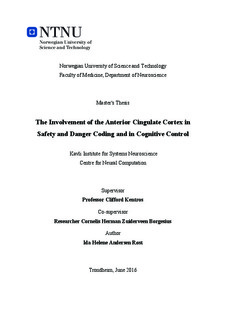| dc.description.abstract | Imagine yourself on a walk in the park. At every moment of time you get bombarded with information; children laughing, dogs barking, birds singing, wind stroking your skin, the smell of grass and green leafs, not to mention all the visual information. Still, you do not focus on all this information all the time. Several regions of your brain work together in deciding which information to use and which to suppress depending on your behavioral goals (Gold and Shadlen, 2007, Walton et al., 2007). The anterior cingulate cortex (ACC) plays a major role in this processing and discrimination of novel information, is particularly active in selective attention when attention is focused on a goal of interest (Isomura et al., 2003, Casey et al., 2000) and in flexible shifting of behavioral states if the goal of interest changes (Kolling et al., 2016, Miller, 2000). Moreover, the ACC is implicated in both cognitive and affective aspects of this information processing (Bush et al., 2000). The neurons of the mouse ACC have also been shown to code for spatial information as certain neurons called annulus cells fire when the mouse explores the perimeter of an open field, while others called bull'seye cells fire when the center is explored (Weible et al., 2012). Because rodents have a natural aversion of open spaces (Montgomery, 1955) we hypothesized that the annulus cells could be a neural correlate of safety and the bull's-eye cells a neural correlate of danger. By use of behavioral tasks and electrophysiological recordings the current study investigated the role of the mouse ACC in selective attention and safety and danger coding. For the selective attention task the mice had to learn a set of behavioral tasks as described by Kolata et al. (2007). We failed to replicate their behavioral results and could therefore not record neural correlates of selective attention. From the safety and danger coding tasks we found that many ACC neurons have shifting firing patterns over several recording sessions. This suggests that the same type of information can be coded in different cells each time it enters the ACC, and that the ACC can be viewed as an integrating structure that fires in response to inputs from other cortical structures. However, some annulus and bull's-eye cells had stable firing patterns over several sessions, which indicate that the ACC also may have specific functions as safety and danger coding. Thus, this study strengthens the hypothesis that the ACC may be involved in safety and danger coding. | nb_NO |
